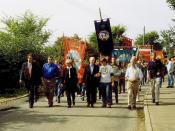In this essay I will show how the conditions surround the 1959 Steel Strike negotiations were much more favorable to the union then the conditions surrounding the negotiations between Kroger and the United Food and Commercial Workers (UFCW). In 1959 the union was able to establish these favorable conditions through a strong labor movement, political involvement, public opinion, and a weak economy. In 2004 the circumstances were much different. Their unfavorable conditions included a weak labor movement, an inactive government, a lack of public opinion, and a strong economy. The best way to think of the differences between the two negotiations is to understand that there has been a shift in ideology from 1959 to 2004. Unions in 1959 had a great deal of strength and numbers. In 1959, unions represented 33% of nonagricultural workers.1 By 2004, the amount of workers represented by unions had dropped to 14%.2 This dramatic change in union membership shows how the power has been shifted to management.
The lack of union members has also made the labor movement less important to the government and to the public. In 1959 most households were affected by the labor movement. This is no longer the case. Regardless of the strength of the recent labor movement I do feel that there is light at the end of the tunnel for organized labor in 2009 and the future.
The conditions surrounding the 1959 Steel Strike were very favorable towards the union. Companies feared the unions and not the other way around. During 1959, the labor movement was strong around the entire country. One third of workers were represented by unions. The steel workers alone accounted for 500,000 workers which was 1% of the total labor force, and produce 90% of domestic made steel.3 This means that a steel strike...


